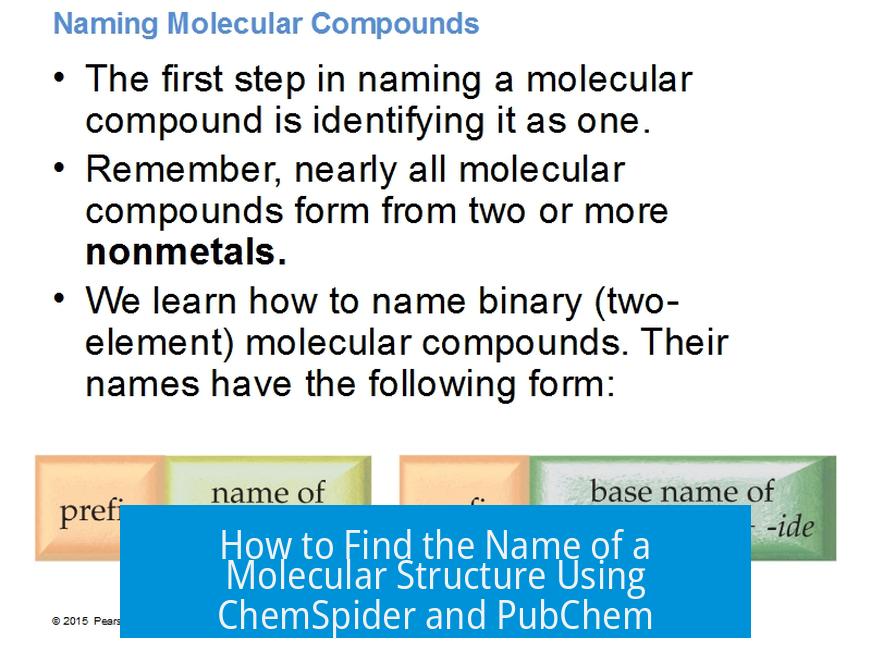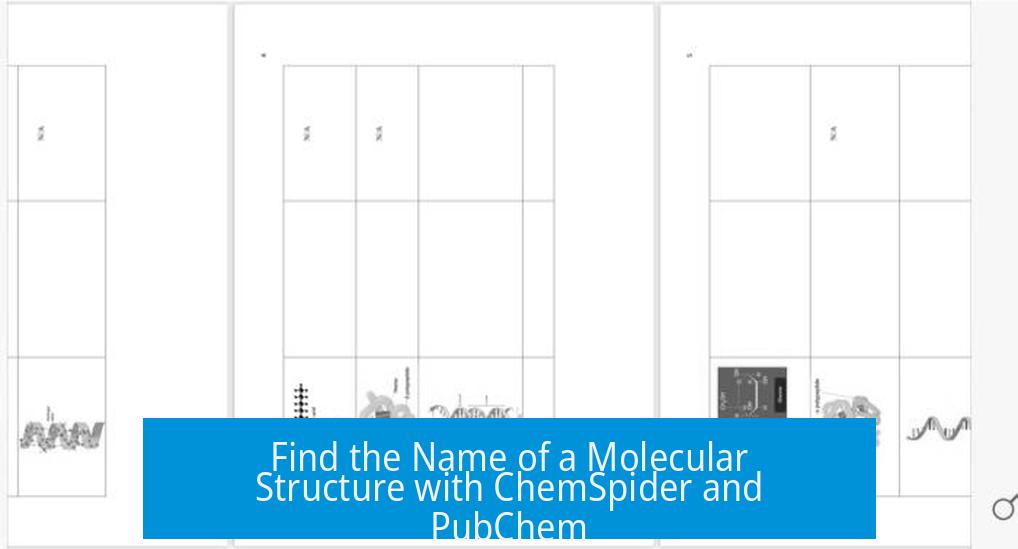How to Find the Name of a Molecular Structure Using ChemSpider and PubChem

Finding the name of a molecular structure reliably involves using specialized chemical databases such as ChemSpider and PubChem. These tools allow users to search molecular structures by inputting chemical formulas, names, or by drawing the molecule. They retrieve exact compound names, identifiers, and related information.
Using ChemSpider and PubChem for Molecular Identification
ChemSpider (https://www.chemspider.com) and PubChem (https://pubchem.ncbi.nlm.nih.gov) are two widely recognized resources for chemists to determine molecular identities. Both databases allow structure searches based on various inputs:
- Exact Structure Drawing: Users can sketch the molecule using an integrated chemical editor.
- Molecular Formula or Name Search: Inputting formulae or common names returns matching molecules.
- Identifier Search: Searching with CAS number, InChIKey, or SMILES strings.
After inputting the structure or information, these platforms retrieve detailed compound data, including official IUPAC names, synonyms, physical and chemical properties, safety information, and linked scientific literature. This approach provides a formal and verifiable compound name rather than guesses.
Benefits of Using Official Chemical Databases
- Reliable Nomenclature: Databases use standardized naming conventions compliant with IUPAC.
- Cross-referenced Data: ChemSpider and PubChem link multiple identifiers for comprehensive recognition.
- Extensive Coverage: Together, they cover millions of substances from small molecules to complex chemicals.
- Free Access: Both platforms are publicly accessible without subscription barriers.
Additional Resources: Reaxys and Reverse Image Search
Sometimes, users may consider alternatives like Reaxys, a commercial chemical information service providing in-depth literature and structure data. For quick heuristics or if traditional searches fail, reverse image search techniques can occasionally help identify molecular structures from diagrams, albeit with less reliability than chemical databases.
Common Challenges in Molecular Name Identification
Despite robust tools, many users post molecular pictures or sketches seeking names without utilizing these resources. This behavior creates problems such as:
- Insufficient Context: Images without elemental details or structural annotations reduce identification accuracy.
- Lack of Familiarity with Tools: Many posters do not know or do not learn how to use ChemSpider or PubChem effectively.
- Ignoring Posting Guidelines: Users often skip instructions advising use of available databases, burdening community responders.
- Low Engagement: Post authors rarely respond to guides suggesting database consults.
Community Responses to Managing Identification Requests
Forums and chemistry communities have proposed measures to handle these persistent demands:
- Posting Bans or Restrictions: Prohibiting posts solely asking for molecule names without prior effort.
- Mandatory Reading: Requiring newcomers to read guides that explain common molecules (e.g., THC, caffeine) and available tools before posting.
- Karma or Account-Age Limits: Restricting identification questions to users with established profiles to encourage responsible use.
These steps aim to reduce repetitive beginner questions and foster application of chemical databases as first-line identification methods.
Educational Value: Learning Through ChemSpider and PubChem
Besides identification, these tools serve an important pedagogical function. Students and chemists use them to practice:
- Naming Conventions: Learning correct IUPAC names for various molecules.
- Drawing Skills: Improving skills in sketching valid chemical structures.
- Understanding Molecular Properties: Accessing related chemical and physical data aids comprehensive learning.
Such engagement promotes independent problem-solving rather than relying on external assistance for names.
Practical Steps to Identify a Molecular Structure
- Use a Structure Editor: Open ChemSpider or PubChem and select the “Draw Structure” tool.
- Sketch the Molecule: Accurately depict atoms, bonds, charges, and stereochemistry as applicable.
- Submit the Query: Run a structure search to retrieve matching compounds.
- Review Results: Check IUPAC name, synonyms, and confirm structure matches original depiction.
- Use Alternative Identifiers: If available, enter CAS number, SMILES, or InChI for faster retrieval.
If no exact match appears, consider:
- Confirming the accuracy of the drawn structure.
- Trying similarity or substructure searches.
- Consulting literature or databases like Reaxys for rare compounds.
- Using reverse image search for published structural diagrams.
Example Scenario
A user draws a molecular structure and wonders if it is cyclopentanone. By inputting the exact structure into PubChem’s editor, the query returns “Cyclopentanone” with the molecular formula C5H8O, confirming the guess. This process avoids ambiguity and validates chemical intuition.
Conclusion: Effective Molecular Name Identification Strategy
Using ChemSpider or PubChem stands out as the most effective and accurate way to find the name of a molecular structure. They combine ease of access, extensive databases, and precise searching mechanisms to yield reliable chemical names. Users should learn to use these tools to enhance understanding and reduce reliance on community guesses or trial-and-error.
- ChemSpider and PubChem enable structure-based and identifier-based searches.
- Additional databases like Reaxys complement for specialized needs.
- Community manages low-effort requests via guidelines and posting restrictions.
- Tools aid in naming practice and skill building in drawing valid molecules.
- Alternative methods like reverse image search may help but are less reliable.





Leave a Comment